1993 BUICK ROADMASTER stop start
[x] Cancel search: stop startPage 107 of 340
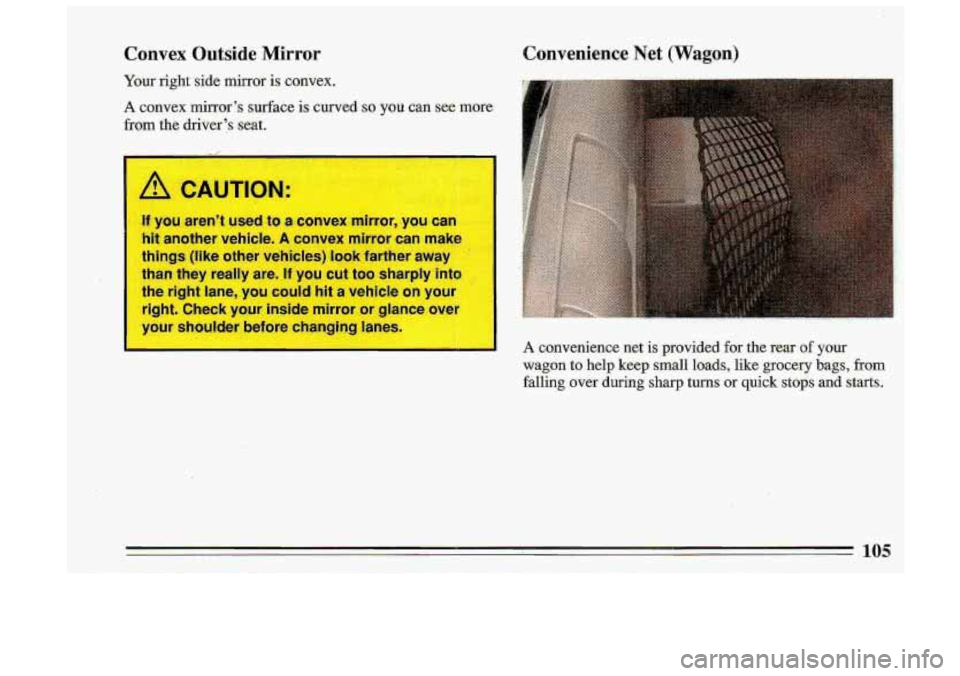
Convex Outside Mirror
Your right side mirror is convex.
A convex mirror’s surface is curved so you can see more
from the driver’s seat.
/d CAUTION:
If you aren’t used to a cor.. 3- mirro IOU can
hit another vehicle. A convex mirror can ma
things (like other vehicles)
look farther away
than they really are. If you cut too sharply
inta
-the right lane, you could hit a vehicle on your
right. Check your inside mirror or glance over - - - ur shoulder before changing lanes.
Convenience Net (Wagon)
A convenience net is provided for the rear of your
wagon
to help keep small loads, like grocery bags, from
falling over
during sharp turns or quick stops and starts.
105
Page 109 of 340

Convenience Net (Sedan)
f
Wagon Cargo Security Cover (Option)
The security cover is used
Your car has a convenience net. You'll see
it just inside
the
back wall of the trunk.
Put-small loads, like grocery bags, behind the net. It can
help keep them from falling over during
sharp turns or
quick starts and stops.
The
net isn't for larger, heavier loads. Store them in the
trunk as far forward as you can.
You can unhook the net so that it will lie flat when
you're .not using it.
41 to cover the rear area when
vou want items hidden from
,
sight.
To use it, pull on the handle
hnd pull the cover all the
way to the tailgate.
Then,
insert each end of the cover
into the slots, making sure
. . . . . . . to get them fully in place.
To return the cover, pull again on the handle, pulling the
cover up and
out of the slots. Gently let the cover roll
back up to the
front.
Be careful not to let go of the cover before it is fully
retracted, as it could be damaged.
The security covercan also be removed from the car.
Each end of the c.over is spring-loaded. Push in either
end towards the center and lift it out from the bracket.
To replace the cover, p.ut one end of .the cover in the
bracket. Then push the other spring in
and insert it into
the bracket.
107
Page 122 of 340
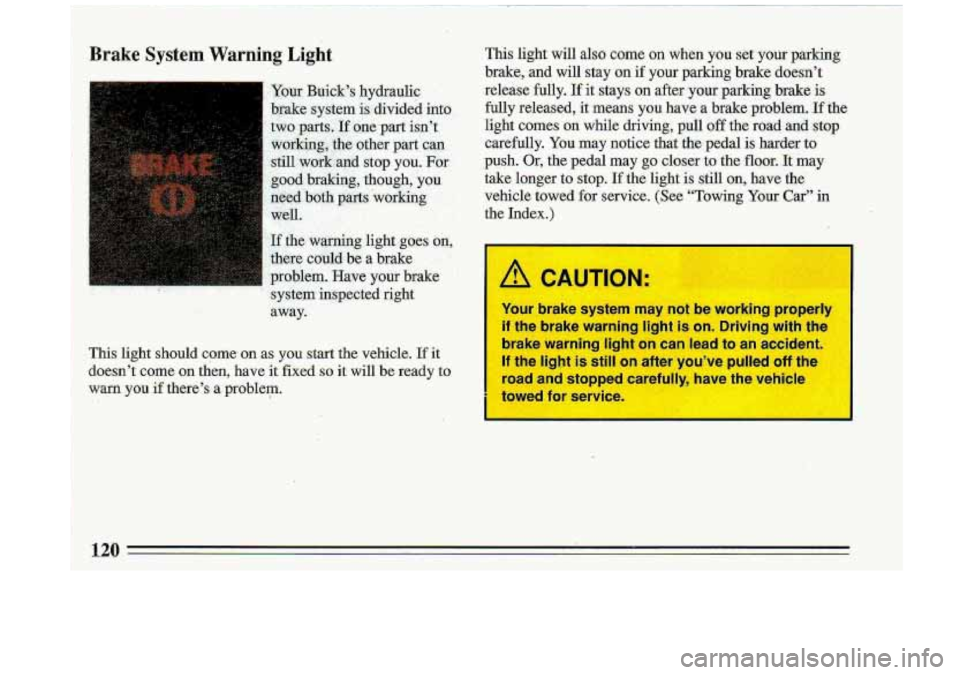
Brake System Warning Light
I Your Buick’s hydraulic .. . -
brake system is divided intd
two parts..If Qne-part isn’t
working, the other
part’ can
stil1,work:aT;lCl stop you. For
g,ood. braking, though, you.
need ‘both parts working,
.. ’.
well. - ’ . i; &. ..
If the. warning light goes an,
there -cbuld be a brake
.L_ ., . - , >.
problem. Have your brake ’
’ system inspected .. . right .. . ,
away.-
. . . , .I
This light should come’ on as you start the vehicle. If it
doesn’t corne on then, have it fixed
so it will be ready to
warn you
if there’s a problem.
This light will also come on when you set your parking
brake,
and will stay on if your parking brake doesn’t
release fully.
If it stays on after. your parking brake is
fully released,
it means you have a brake problem. If the
light comes on while driving, p.d off the- road and stop
carefully. You may notice that the pedal is harder
to
push. Or, the pedal may go closer to the floor. It may
take longer to stop.
If the light is still on, have the-
vehicle towed for service. (See “Towing Your Car” in
the Index.)
/! CAUTION.
Your brake system may not be working properly
if the brake warning light is on. Driving with the
brake warning light on can
lead to an accident.
If the light is still on after you’ve pulled off the
road and stopped carefully, have the vehicle
ta
?d for SE ice
Page 123 of 340

iI
Anti-Lock Brake System Warning Light
. -, i’
.. I. ,:,:
With anti-lock, this light will go on when you start your
engine and may stay on for several seconds or
so. That’s
normal.
If the light doesn’t come on, have it fixed so it
will be ready to warn you if there is a problem.
If the light stays on or comes on when you’re driving,
stop as soon as possible and turn the key
off. Then start
the engine to reset the system.
If the light still stays on,
or comes on again while you’re driving, your Buiek
needs service. Unless the regular ‘brake system warning
light is also
on, you will still have brakes, but not
anti-lock brakes.
If the regular brake system warning
light is also
on, see “Brake System Warning Light”
earlier
in this part.
The anti-lock brake system warning .light may also come
on when you are driving with
a compact spare. tire, If
this happens, the light means you won’t have anti-lo,ck
until you replace the compact spare ,with
.a fuU-simtire.
If the anti-lock brake system warning light stays
on after
you replace the compact spare with a full-size tire, or if
it comes
on again when you’re driving, your Buick
needs service.
121
Page 148 of 340
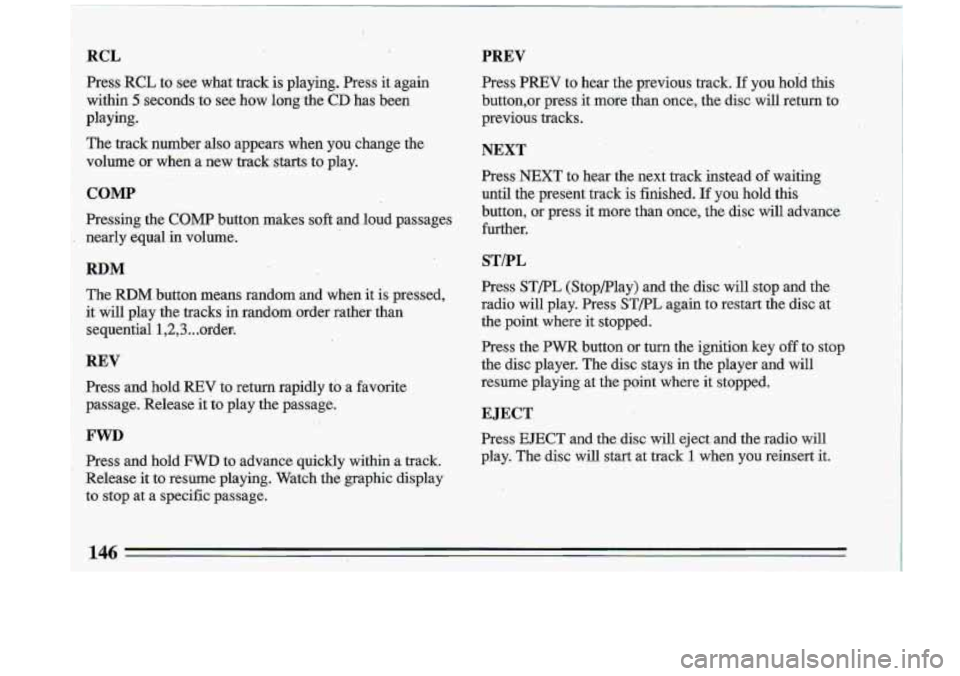
RCL
Press :RCL to see what-track is playing. Press it again
within
5 seconds ,to see how long 'the CD has been
playing,.
The track number also appears
when you change the
volume or when a new track starts to play.
COMP
Pressing the COMP button makes soft and loud passages
nearly equal in volume. I.
RDM
The RDM button means random and when it is pressed,
it
will play the tracks in random order rather than
sequential
1,2,3.. .orden
REV
Press and hold REV to return rapidly to a favorite
passage. Release it
to play the passage.
FWD
Press and hold FWD to advance quickly within a track.
Release it to resume playing. Watch the graphic display
to stop at a specific passage.
PREV
Press PREV to hear the previous track. If you hoId this
button,or press it more than once, the dis.c. w-j&g&turn
t
previous tracks.
NEXT
Press NEXT to hear the next track instead of waiting
until the present track
is finished. If you hold this
button, or-press it more than once, the disc will advance
further.
STlPL
Press ST/PL (Stop/Play) and the disc will stop and the
radio
will play. Press ST/PL again to restart the disc at
the point where it stopped.
Press the
PWR button or turn the ignition key off to stop
the disc player. The disc stays in the player
and will
resume playing
at the point where it stopped.
EJECT
Press EJECT and the-disc will eject and the radio will
play. The disc will start at track
1 when you reinsert it.
146
Page 161 of 340
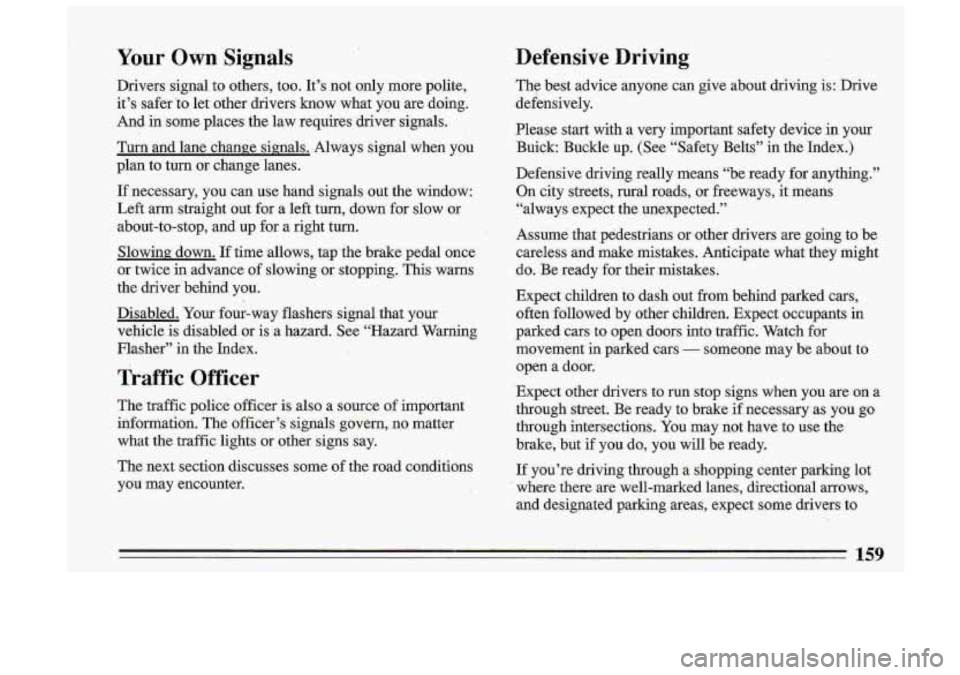
Your Own Signals Defensive Driving
Drivers signal
to others, too. It’s not only more polite,
it’s safer ‘to let other drivers know what you are doing.
And in some places the law requires driver signals.
Turn and lane change signals. Always signal when you
plan to turn or change lanes.
If necessary, you can
use hand signals out the window:
Left arm straight out for
a left turn, down- for slow or
about-to-stop, and up for a right turn.
Slowing. down. If time allows, tap the brake pedal once
or twice
in advance of slowing or stopping. This warns
the driver behind you.
Disabled. Your -four-way flashers signal that your
vehicle is disabled or is a hazard. See “Hazard Warning
Flasher” in the Index.
Traffic Officer
The traffic police officer is also a source of important
information.
The officer’s signals govern, no matter
what the traffic lights or other signs say.
The next section discusses some of the road conditions
you
may encounter. The
best advice anyone can give about driving is: Drive
i
defensively. !
Please start with a very important safety device in your
Buick: Buckle up. (See “Safety Belts” in the Index.) i
Defensive driving really means “be ready for anything.”
On city streets, rural roads, or freeways, it means
“always expect the unexpected.”
Assume that pedestrians or other drivers are going to be
careless and make mistakes. Anticipate what they might
do. Be ready for their mistakes.
Expect children to dash out from behind parked cas,
often-followed by other children. Expect occupants
in
parked cars to open doors into traffic., Watch for
movement
in parked cars - someone may be about to
open a door.
Expect other drivers to run stop signs when. you are on a
through street. Be ready to brake if necessary
as you go
through intersections. You may not have
to use the
brake, but if you do, you will be ready.
If you’re driving through a shopping center parking lot
where there are well-marked lanes, directional arrows,
and designated parking areas, expect.some drivers to
159
__
Page 180 of 340
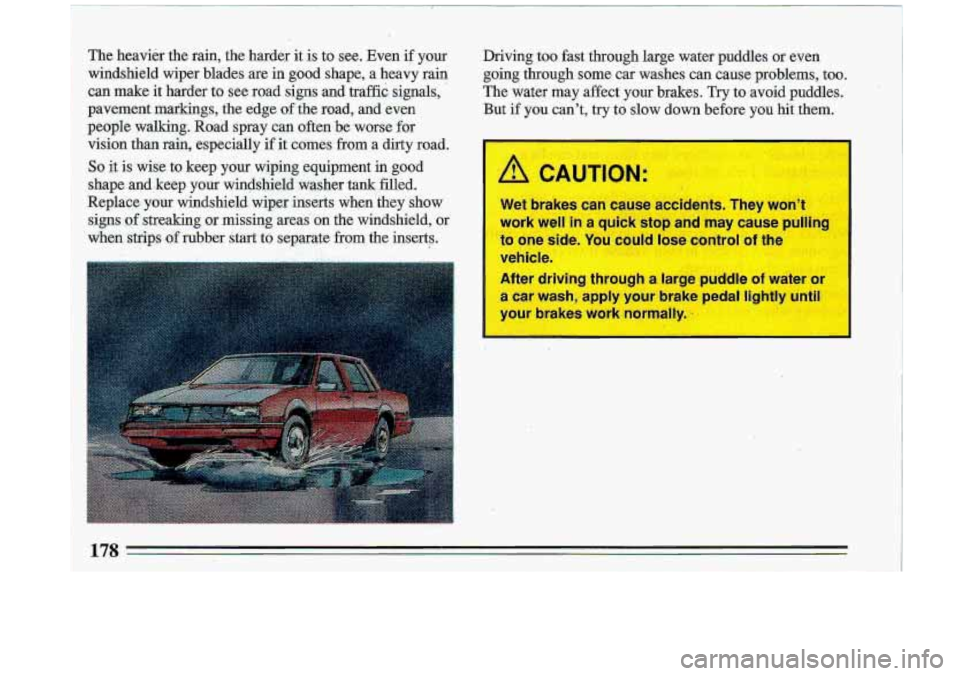
The heavier the rain, the harder it is to see. nven if your
windshield wiper blades are in good shape, a heavy rain
,can make it harder to see road signs and traffid. signals, .
pavement markings, the edge of the road, and even
people walking. Road spray can often be worse for
vision than rain, especially if it
comes frum a dirty road.
So it is wise to keep your wiping equipment in good i.
shape and :keep your windshieklwasher tank filled.
Replace
your windshield' wiper inserts when 'they' show
signs
.of streaking-or missing areas on the windshield, or
when strips
of rubber start to separate from the inserts. Driving,
too fast through large water puddles or even
going through some car washes can cause problems,
too.
The water may affect your brakes. Try to avoid puddles.
But
if you can't, try to slow down before you hit them.
A I
,A CA JTION:
Wet brakes can cause accidents. They won't
work well in a quick stop and may cause pl ng
to one side.
Yo Zould lo! eo - *oI of -- 3
vehicle.
After driving thro
-=-- -i la.,e p-Jdle 0. ,later
a car wash, apply your brake aedal liahtly unt
1 Iur brakes work normal
178
Page 183 of 340

Tips on Driving in Fog
If you get caught in fog, turn your headlights on low
beam, even in daytime. You’ll see
- and be seen -
better.
Pass other vehicles in fog only if you can see far enough
ahead to pass safely. Even then, be prepared to delay
your pass if you suspect the
fog.is worse up ahead. If
other vehicles try to pass you, make it easy for them.
*
If visibility is near zero and you must stop but are
unsuTe whether you are away
from the road, turn your
lights on, start
your hazard warning flasher, and sound
your
Born at intervals or when you hear approaching
traffic. One
of the
biggest problems with city streets is the
amount of traffic
on them. You’ll want to watch out for
what the other drivers are doing and pay attention
to
traffic signals.
181